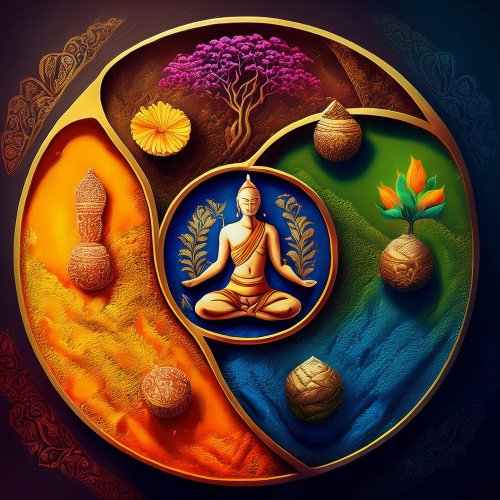Understanding Prakriti in Ayurveda
Introduction
Prakriti, derived from Sanskrit, means "nature" or "constitution." In Ayurveda, it represents an individual's unique physical, mental, and emotional make-up, determined by the predominance of the three doshas: Vata, Pitta, and Kapha.
What is a Dosha? Dosha refers to the three fundamental biological energies or forces that govern the functioning of our bodies and minds. Each dosha is composed of two of the five basic elements (Ether, Air, Fire, Water, and Earth) and has distinct qualities and roles:
Vata Dosha (Ether and Air): Governs movement, communication, and sensory activities.
Pitta Dosha (Fire and Water): Governs digestion, metabolism, and transformation.
Kapha Dosha (Water and Earth): Governs structure, stability, and lubrication.
Understanding one's Prakriti is fundamental to personalized healthcare in Ayurveda, as it guides lifestyle, diet, and therapeutic interventions tailored to each person's unique constitution.
The Three Doshas
1. Vata Dosha
Elements: Air and Ether (Space)
Qualities: Dry, Light, Cold, Rough, Subtle, Mobile
Functions: Vata governs movement, communication, and sensory activities. It controls blood flow, breathing, and the movement of nutrients and waste.
Characteristics: People with a Vata-dominant constitution are often energetic, creative, and expressive. They may have a thin build, dry skin, and cold hands and feet. When imbalanced, they may experience anxiety, restlessness, and digestive issues.
2. Pitta Dosha
Elements: Fire and Water
Qualities: Hot, Sharp, Light, Intense, Oily, Fluid
Functions: Pitta governs digestion, metabolism, and transformation in the body. It is responsible for body temperature regulation, vision, and intelligence.
Characteristics: People with a Pitta-dominant constitution are typically strong-willed, intelligent, and ambitious. They may have a medium build, warm skin, and a strong appetite. When imbalanced, they may experience irritability, inflammation, and heartburn.
3. Kapha Dosha
Elements: Water and Earth
Qualities: Heavy, Slow, Steady, Solid, Cold, Soft, Oily
Functions: Kapha governs structure, stability, and lubrication. It provides physical and emotional support, controls immunity, and hydrates tissues.
Characteristics: People with a Kapha-dominant constitution are often calm, nurturing, and resilient. They may have a larger build, smooth skin, and a steady energy level. When imbalanced, they may experience lethargy, weight gain, and congestion.
how to Determing your Prakriti
Determining an individual's Prakriti involves a thorough assessment by an Ayurvedic practitioner, considering physical traits, personality, and habits. Key factors include:
Physical Examination: Observing body structure, skin texture, hair type, and facial features.
Mental and Emotional Traits: Evaluating personality traits, emotions, and behavior patterns.
Lifestyle and Habits: Analyzing daily routines, dietary preferences, and sleep patterns.
A balanced Prakriti is necessary to maintain health; so, consider getting your Ayurvedic assessment to find out about your Prakriti.
Prakriti and Health
Understanding Prakriti helps in adopting preventive measures and personalized treatments to maintain balance and harmony within the body. Key benefits include:
Preventive Care: Identifying dietary and lifestyle choices that suit one's Prakriti to prevent health issues.
Personalized Treatment: Tailoring Ayurvedic treatments such as herbal remedies, massages, and detoxification therapies to an individual's Prakriti for effective healing.
Practical Tips for Balancing Doshas and prakriti
Dietary Recommendations:
Vata dosha people should consume warm, moist, and grounding foods like cooked grains, root vegetables, and soups. They should avoid raw, cold, and dry foods.
Pitta dosha people should consume cooling, mild, and hydrating foods like fresh fruits, vegetables, and salads. They should Avoid spicy, acidic, and salty foods.
Kapha dosha people should consume light, dry, and warming foods like legumes, vegetables, and spices. They should avoid heavy, oily, and sugary foods.
Lifestyle Practices:
Vata people should establish a regular routine, practice gentle exercises like yoga, and ensure adequate rest.
Pitta people should engage in calming activities, avoid excessive heat and stress, and practice moderation.
Kapha people should incorporate vigorous exercise, stay active, and avoid heavy and sedentary routines.
Herbal Remedies:
Vata: Ashwagandha, ginger, and licorice.
Pitta: Aloe vera, turmeric, and coriander.
Kapha: Triphala, ginger, and black pepper.
Conclusion
The Ayurveda's holistic approach to health emphasizes the importance of understanding and balancing Prakriti. By aligning lifestyle choices, dietary habits, and treatments with one's unique constitution, individuals can achieve optimal health and well-being. I encourage you to learn more and find out about your Prakriti and embrace the Ayurvedic principles to lead a balanced and fulfilling life.
Reminder: For an accurate assessment of your Prakriti and personalized guidance, it's best to consult a certified Ayurvedic professional. They can provide a comprehensive evaluation and recommend appropriate lifestyle and dietary adjustments tailored to your individual needs.
